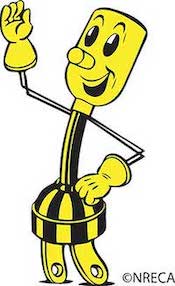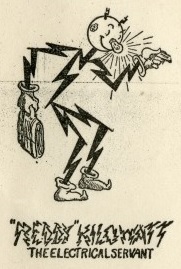Willie Wiredhand
| Willie Wiredhand | |
|---|---|
 Willie Wiredhand | |
| First appearance | October 30, 1950 |
| Created by | Andrew "Drew" McLay |
| In-universe information | |
| Gender | Male |
| Occupation | Rural electric cooperative ambassador |
Willie Wiredhand is the cartoon mascot of the National Rural Electric Cooperative Association, created in 1950 and still in use by co-op electricity companies. His head is a lightbulb socket, his body is a wire, and his hips and legs are a two-pronged power plug. Willie was created as a rival for the corporate Reddy Kilowatt, which led to a lawsuit in 1956 alleging trademark infringement; the case was resolved in Willie Wiredhand's favor and Willie was granted his own trademark in 1957. The character has appeared in a wide range of advertising and merchandise, with a lull in popularity after the 1970s followed by a 2000s revival.
Creation
[edit]
Willie Wiredhand was created when the National Rural Electric Cooperative Association (NRECA) was unable to license the Reddy Kilowatt mascot from Ashton B. Collins Sr.[1] Collins created his Reddy Kilowatt mascot in 1934 to promote private investor-owned utilities.[2] These investor-owned utilities did not consider it sufficiently profitable to build electric infrastructure in rural areas.[3] In 1936, the Rural Electrification Act provided federal loans for rural co-ops to build non-profit electric infrastructure through democratically-elected organizations.[3][4] This program was part of Franklin D. Roosevelt's "New Deal", and continues as the Rural Utilities Service in the United States Department of Agriculture.[3][4] The NRECA was founded in 1942 as a trade organization to represent these rural co-ops and provide additional services which were too expensive individually.[2] In 1948, Collins refused to license the Reddy Kilowatt character to rural electrical co-ops, on the grounds that it would harm the reputation of the investor-owned utilities to be associated with the federally-subsidized rural programs.[2][5] In response, the NRECA had a contest to design their own mascot.[1]
The mascot contest was announced in Rural Electrification Magazine in December 1948, with a $50 prize for the best design.[2] The freelance artist Andrew "Drew" McLay designed "Willie the Wired Hand", with the "birthday" of October 30, 1950.[6] The name is a play on the phrase "hired hand", a common term for agricultural laborers.[7] Willie's body is a wire, with the prongs of a plug as his legs, and a lightbulb socket with a push-button as his head and nose.[7] He wears the thick gloves of a lineworker.[8] This character, with the slightly revised name "Willie Wiredhand", was chosen as the contest winner in 1951.[1] He advertised electricity as "the never-tiring, always available hired hand to help the nation's farmers."[6]
Lawsuit
[edit]Collins challenged NRCEA's right to its own mascot as soon as the mascot design contest was announced, writing that Collins was "the originator and owner of figures symbolizing the use of electric energy".[2] The first lawsuit was filed in 1953 in South Carolina's federal district court.[5] This case was decided in the co-ops' favor in 1956, and Collins appealed to the U.S. Court of Appeals Fourth Circuit.[5] The three judges unanimously ruled that the lower court's decision held, dismissing the complaint on January 7, 1957.[5] The court held that there was no trademark confusion.[9] The opinion, written by Judge Harry E. Watkins, stated that "[t]he names Reddy Kilowatt and Willie Wiredhand are entirely different. The two figures themselves do not look alike."[10] The NRCEA successfully countersued for their court costs.[9] Willie Wiredhand was granted his own trademark by the U.S. Patent Office in 1957.[5]
Appearances and uses
[edit]As an advertising mascot, Willie appeared consistently in advertisements and newsletters from NRCEA's electrical companies.[11] Beginning in 1956, Willie was the face of a cooperative group of electronics retailers, who could advertise as official "Willie Wiredhand Dealers".[12] A political campaign, "Minutemen for Rural Electrification", included an image of Willie dressed as a Minuteman, which appeared on stage behind then-Senator John F. Kennedy at a 1959 NRECA event in Washington, D.C.[13] In the 1960s, a family group of musicians known as The Willie Wiredhand Serenaders hosted a local television show, sponsored by several electric co-ops,[14] and gave touring performances.[15] The Southwestern Electric Company sponsored a softball team called Willie Wiredhand in Arkansas.[16] Two comic books were published in 1967 and 1968, "Cousin Johnny Discovers Power in Rural America" and its sequel "It's Annual Meeting Time for the Davis Family," which starred Willie explaining rural co-op electrification.[17] A five-foot animatronic mascot at the office of the Electric Power Associations of Mississippi could move its arms and speak.[18] Branded items including Willie Wiredhand wristwatches and aprons were given as prizes for sponsored local events.[19][20]
There was a lull in Willie Wiredhand merchandise and branding after the late 1970s.[21] By 1997, Willie was rarely seen.[22] The RECs of Oklahoma, for example, switched to a less cartoonish logo some time before 2001.[23] In the early 2000s he began to regain popularity.[21] An animated neon sign of Willie in Sand Point, Seattle, created in the 1950s and out of repair for decades, was restored in 2000 through a crowdfunding campaign.[8][24] The NRCEA produces an annual Christmas ornament of Willie,[18] and other items have included bobbleheads[21] and handmade pens.[25]
References
[edit]- ^ a b c Byrd, Sandra (2019-11-02). "Willie Wiredhand: A symbol of co-op pride". Arkansas Living Magazine. Archived from the original on 2022-11-28. Retrieved 2021-10-10.
- ^ a b c d e Reddy-Kilowatt v. Mid-Carolina Electric Cooperative, 142 F. Supp. 851 (Report). 1956-06-15.
- ^ a b c Brinkman, Marilyn Salzl. "In 1940s, electricity changed the farm economy". SC Times. Retrieved 2021-10-10.
- ^ a b Sherman, Howard J.; Hunt, E. K.; O'Hara, Phillip (2008). Economics: An Introduction to Traditional and Progressive Views. M.E. Sharpe. pp. 281–282. ISBN 978-0-7656-2822-0.
- ^ a b c d e Biever, Richard G. (2015-01-27). "Golden Boy". Indiana Connection. Retrieved 2021-10-10.
- ^ a b "Willie Wiredhand as RMEC mascot". The Mena Star. Archived from the original on 2021-10-10. Retrieved 2021-10-10.
- ^ a b Mitnick, Steve. "Reddy Kilowatt Versus Willie Wiredhand". Retrieved 2021-10-10.
- ^ a b "Neon icon 'Willie' back in the blink". The Spokesman-Review. 2000-04-06. p. 5. Retrieved 2025-02-04.
- ^ a b "The Ballad of Chief Lightning Bolt". Albuquerque Journal. 1988-01-26. p. 45. Retrieved 2025-02-04.
- ^ "Public Power's Willie Wins Fight For Survival". Wall Street Journal. 1956-06-26. ISSN 0099-9660. ProQuest 132264420. Retrieved 2021-10-11.
- ^ "Cartoons brand old electricity advertising". St. Cloud Times. 2005-06-11. p. 23. Retrieved 2025-02-04.
- ^ "Electrical Appliance Dealers Pledge Quality Service in New Program". The Times-Herald. 1956-10-04. p. 20. Retrieved 2025-02-04.
- ^ "Meet the Mascot: Willie Wiredhand". Archived from the original on 2021-10-21. Retrieved 2021-10-10.
- ^ "Former Cityan To Appear On Big TV Show". Okmulgee Daily Times. 1960-12-16. p. 3. Retrieved 2025-02-04.
- ^ "The Willie Wiredhand Serenaders". Hume Border Messenger. 1962-09-27. p. 2. Retrieved 2025-02-04.
- ^ "Recreation, Wiredhand Win Contests". Northwest Arkansas Times. 1961-08-09. p. 21. Retrieved 2025-02-04.
- ^ Biever, Richard G. (2016-06-30). "65 & Pluggin' On". Retrieved 2021-10-11.
- ^ a b MECA (2014-12-19). "Willie Wiredhand Is Alive and Well". meca.coop. Retrieved 2025-01-26.
- ^ "Tri-County annual meeting". The Excelsior. 1995-08-09. p. 1. Retrieved 2025-02-04.
- ^ "Graduation Parties". Shiner Gazette. 1972-06-22. p. 1. Retrieved 2025-02-04.
- ^ a b c "Meet the mascot: Willie Wirehand | Paulding Putnam Electric Cooperative". ppec.coop. Retrieved 2025-01-26.
- ^ "There is little love lost". The Daily Inter Lake. 1997-02-16. p. 12. Retrieved 2025-02-05.
- ^ "My Two Scents Worth". Sequoyah County Times. 2001-01-18. p. 3. Retrieved 2025-02-04.
- ^ "Sign Saviors: Willie Wiredhand back at work for Northern Lights". Bonner County Daily Bee. 2000-04-07. p. 1. Retrieved 2025-02-04.
- ^ mringelstetter (2017-07-21). "Pens Celebrate Co-op Culture". America's Electric Cooperatives. Retrieved 2025-01-26.
